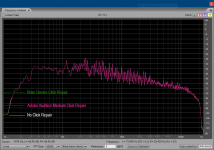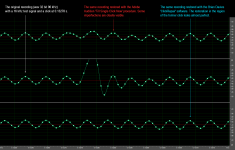Member
Joined 2019
Not sure what you mean by parameters, sample rate, bit depth?
Yes, I meant this + media data. I was not quite sure about the years, but the material linked by gpapag in post 80 confirms, that they were the 70ies. We find also digital files parameters data:
1972. Denon DN-023R, 13-bit 47.25kHz.
1977. Denon DN-034R, 14 bits with emphasis (equivalent to 15.5 bits), 47.25 kHz
etc.
Media: tape.
Member
Joined 2019
Very nice info!
As for the FFT analysis of the editing comparison files, I get the same pictures (naturally). I am thinking about the reason of level rising in the lowest frequencies, introduced by the ClickRepair procedure, although the interest is rather theoretical. This has to do with the Brian Davies software. I will repeat this step using some of the Audition own de-click tools, to see what happens then.
Last edited:
Member
Joined 2019
To gpapag
I attach a comparison of 3 analysis files. In 64k FFT - higher detail is not important here. Left channels only. Click repair rises the level of lowest frequencies also in it's Adobe Audition variant, but in less extent. This is a puzzle for me, but the explanation may be quite trivial … ? ?
I attach a comparison of 3 analysis files. In 64k FFT - higher detail is not important here. Left channels only. Click repair rises the level of lowest frequencies also in it's Adobe Audition variant, but in less extent. This is a puzzle for me, but the explanation may be quite trivial … ? ?
Attachments
Last edited:
Thanks.
Probably the low freq noise increase depends on the amount of mathematical manipulations each SW applies to the signal.
The jazz file is 48kHz/24bit. I ask for clarification the following:
At what bit depth did you record the jazz file ?
At what bit depth did you perform each processing?
Did you perform dithering at all? If yes, where in the process chain?
George
Probably the low freq noise increase depends on the amount of mathematical manipulations each SW applies to the signal.
The jazz file is 48kHz/24bit. I ask for clarification the following:
At what bit depth did you record the jazz file ?
At what bit depth did you perform each processing?
Did you perform dithering at all? If yes, where in the process chain?
George
Member
Joined 2019
Hi.Thanks.
Probably the low freq noise increase depends on the amount of mathematical manipulations each SW applies to the signal.
The jazz file is 48kHz/24bit. I ask for clarification the following:
At what bit depth did you record the jazz file ?
At what bit depth did you perform each processing?
Did you perform dithering at all? If yes, where in the process chain?
George
1. The file was recorded at what Adobe Audition calls "32 bit (float)"
2. All the processing was performed in the same bit depth
3. I did not apply dithering. But I do not know whether dithering was applied as a part of some of the procedures I used.
Check the documentation of the SW. Somewhere there will mention it.
When your final step is to convert from 32bit to 24bit, you might apply dither there (mandatory when going down to 16bit).
You may try it to see if the low level noise goes down when applying dithering.
Most SWs ask for dithering before saving to lower bit depths.
Check that too in the documentation, it is important.
Make a test on the dither/save sequence, compare results to confirm.
George
When your final step is to convert from 32bit to 24bit, you might apply dither there (mandatory when going down to 16bit).
You may try it to see if the low level noise goes down when applying dithering.
Most SWs ask for dithering before saving to lower bit depths.
Check that too in the documentation, it is important.
Make a test on the dither/save sequence, compare results to confirm.
George
Member
Joined 2019
Member
Joined 2019
Member
Joined 2019
Hello,
is it possible to get the file with the click? I'm interested to test it with declick from Izotope RX6
Hi. I send a link to a bigger mono file, with a lot of different clicks and pops over a weak 16 kHz signal. The click I used is at time 29.43292 s. To get an easy comparison of the original and the treated record, I convert the mono file to stereo (L=R) and apply the click removal procedure to the right channel only.
Click Analysis 96 kHz.wav - Google Drive
Last edited:
You may be quite knowledgeable in nuclear physics, but this specific IM topic is definitely over your head.Using the AA signal generator, I created a 315 Hz signal, modulated by 0.55 Hz of 1% level ( = 331/3 LP with eccentricity of 1% ). With 1 M FFT I see exactly what I expected:
1. Instead of a sharp peak at 315 Hz, I see a region of frequencies: 306 - 324 with the intensity varying with the frequency of 0.55 Hz.
2. No trace of 0.55 Hz.
In 1. and 2. I demonstrate again my purist use of the term "frequency". A gentleman wrote me "You are not looking in the correct region". When purist, I look for 0.55 Hz where I see written, in the axis x, "0.55 Hz".
But I think the misunderstanding is over. Greetings.
315 1% ecc 0.55.wav - Google Drive
The problems though seems that you are not open to learn from others, some with tons of experience.
Hans
Member
Joined 2019
Yes Sir. I am not open to learn that the radio spectrum of a 100 MHz FM station includes some tens of kHz radio components!You may be quite knowledgeable in nuclear physics, but this specific IM topic is definitely over your head.
The problems though seems that you are not open to learn from others, some with tons of experience.
Hans
I am also not open to learn that the skating force "disappears" as a result of the antiskating device operation.
Deeply sorry.
You must be a very lucky man.Yes Sir. I am not open to learn that the radio spectrum of a 100 MHz FM station includes some tens of kHz radio components!
I am also not open to learn that the skating force "disappears" as a result of the antiskating device operation.
Deeply sorry.
Try to keep your ignorance.
Hans
Member
Joined 2019
You must be a very lucky man.
Try to keep your ignorance.
Yes, I am quite lucky to be in the field nearly 60 years. I was first year student of physics at 1962. I was already an active DIY Hi-Fi person, I knew about amplitude and frequency modulation, linear and non-linear distortion, inter-modulation distortion etc. It is funny to see today some people trying to teach me all this again, in a not very polite manner..
Yes, I am quite lucky to be in the field nearly 60 years. I was first year student of physics at 1962. I was already an active DIY Hi-Fi person, I knew about amplitude and frequency modulation, linear and non-linear distortion, inter-modulation distortion etc. It is funny to see today some people trying to teach me all this again, in a not very polite manner..
This is an argument from authority and no one should ever use it.
On top of that, solely based on what you've written here, a 1 year physics study doesn't qualify you for being an expert in electrical engineering.
Member
Joined 2019
Neither 20 years of studyING others, as a university professor.a 1 year physics study doesn't qualify you for being an expert in electrical engineering.
Bill, you are a very arrogant person. Goodbye.
Member
Joined 2019
My first DIY
Not within the thread theme, but not the first to be this way.. BTW, it would be nice to have a thread "My first DIY". Maybe it exists already? If not, could somebody create one, if he/she finds it interesting?
My first DIY was a "crystal radio", based on a crystal/cat's whisker diode, a simple LC circuit tuned at AM MW and listened by piezo-electric headphones. An important part of the job was to find a "good" contact of the cat's whisker needle with the PbS crystal surface. This had to be done frequently. A second important part, done only once per listening place, was to establish a long and high AM antenna. When in summer vacation, I used a 50 m wire, part of which I threw up to some high tree not very close to my listening place and then strained the rest to this place. I was in Bulgaria at that time and I remember that the most strong and well listenable station was "The Voice of America transmitted from Thessaloniki".
This was 61 years ago. And I knew already what "amplitude modulation" and "amplitude demodulation" means. I could never imagine that I will have to 'learn' it again after 61 years!
Some illustrations by other authors:
.
Not within the thread theme, but not the first to be this way.. BTW, it would be nice to have a thread "My first DIY". Maybe it exists already? If not, could somebody create one, if he/she finds it interesting?
My first DIY was a "crystal radio", based on a crystal/cat's whisker diode, a simple LC circuit tuned at AM MW and listened by piezo-electric headphones. An important part of the job was to find a "good" contact of the cat's whisker needle with the PbS crystal surface. This had to be done frequently. A second important part, done only once per listening place, was to establish a long and high AM antenna. When in summer vacation, I used a 50 m wire, part of which I threw up to some high tree not very close to my listening place and then strained the rest to this place. I was in Bulgaria at that time and I remember that the most strong and well listenable station was "The Voice of America transmitted from Thessaloniki".
This was 61 years ago. And I knew already what "amplitude modulation" and "amplitude demodulation" means. I could never imagine that I will have to 'learn' it again after 61 years!
Some illustrations by other authors:
.
Attachments
- Status
- This old topic is closed. If you want to reopen this topic, contact a moderator using the "Report Post" button.
- Home
- Source & Line
- Analogue Source
- Editing of digitized vinyl music - Pros and Cons


